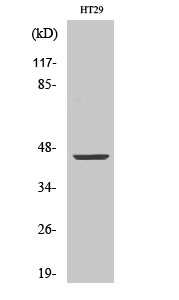TRAAK Polyclonal Antibody
- SPECIFICATION
- CITATIONS
- PROTOCOLS
- BACKGROUND

Application
| WB |
|---|---|
| Primary Accession | Q9NYG8 |
| Reactivity | Human, Mouse |
| Host | Rabbit |
| Clonality | Polyclonal |
| Calculated MW | 42704 Da |
| Gene ID | 50801 |
|---|---|
| Other Names | KCNK4; TRAAK; Potassium channel subfamily K member 4; TWIK-related arachidonic acid-stimulated potassium channel protein; TRAAK; Two pore potassium channel KT4.1; Two pore K(+) channel KT4.1 |
| Dilution | WB~~Western Blot: 1/500 - 1/2000. ELISA: 1/40000. Not yet tested in other applications. |
| Format | Liquid in PBS containing 50% glycerol, 0.5% BSA and 0.09% (W/V) sodium azide. |
| Storage Conditions | -20℃ |
| Name | KCNK4 {ECO:0000303|Ref.2, ECO:0000312|HGNC:HGNC:6279} |
|---|---|
| Function | K(+) channel that conducts voltage-dependent outward rectifying currents upon membrane depolarization. Voltage sensing is coupled to K(+) electrochemical gradient in an 'ion flux gating' mode where outward but not inward ion flow opens the gate. Converts to voltage-independent 'leak' conductance mode upon stimulation by various stimuli including mechanical membrane stretch, basic pH, heat and lipids (PubMed:22282805, PubMed:25471887, PubMed:25500157, PubMed:26919430, PubMed:30290154, PubMed:38605031). Homo- and heterodimerizes to form functional channels with distinct regulatory and gating properties (PubMed:26919430). At trigeminal A-beta afferent nerves, the heterodimer of KCNK2/TREK-1 and KCNK4/TRAAK is mostly coexpressed at nodes of Ranvier where it conducts voltage-independent mechanosensitive and thermosensitive currents, allowing rapid action potential repolarization, high speed and high frequence saltatory conduction on myelinated nerves to ensure prompt sensory responses (By similarity). Permeable to other monovalent cations such as Rb(+) and Cs(+) (PubMed:26919430). |
| Cellular Location | Cell membrane; Multi-pass membrane protein. Cell projection, axon {ECO:0000250|UniProtKB:G3V8V5}. Note=Localizes at the Ranvier nodes of myelinated afferent nerves {ECO:0000250|UniProtKB:G3V8V5} |

Thousands of laboratories across the world have published research that depended on the performance of antibodies from Abcepta to advance their research. Check out links to articles that cite our products in major peer-reviewed journals, organized by research category.
info@abcepta.com, and receive a free "I Love Antibodies" mug.
Provided below are standard protocols that you may find useful for product applications.
Background
Voltage-insensitive potassium channel (PubMed:22282805). Channel opening is triggered by mechanical forces that deform the membrane (PubMed:22282805, PubMed:25471887, PubMed:25500157). Channel opening is triggered by raising the intracellular pH to basic levels (By similarity). The channel is inactive at 24 degrees Celsius (in vitro); raising the temperature to 37 degrees Celsius increases the frequency of channel opening, with a further increase in channel activity when the temperature is raised to 42 degrees Celsius (By similarity). Plays a role in the perception of pain caused by heat (By similarity). Plays a role in the sensory perception of pain caused by pressure (By similarity).
If you have used an Abcepta product and would like to share how it has performed, please click on the "Submit Review" button and provide the requested information. Our staff will examine and post your review and contact you if needed.
If you have any additional inquiries please email technical services at tech@abcepta.com.













 Foundational characteristics of cancer include proliferation, angiogenesis, migration, evasion of apoptosis, and cellular immortality. Find key markers for these cellular processes and antibodies to detect them.
Foundational characteristics of cancer include proliferation, angiogenesis, migration, evasion of apoptosis, and cellular immortality. Find key markers for these cellular processes and antibodies to detect them. The SUMOplot™ Analysis Program predicts and scores sumoylation sites in your protein. SUMOylation is a post-translational modification involved in various cellular processes, such as nuclear-cytosolic transport, transcriptional regulation, apoptosis, protein stability, response to stress, and progression through the cell cycle.
The SUMOplot™ Analysis Program predicts and scores sumoylation sites in your protein. SUMOylation is a post-translational modification involved in various cellular processes, such as nuclear-cytosolic transport, transcriptional regulation, apoptosis, protein stability, response to stress, and progression through the cell cycle. The Autophagy Receptor Motif Plotter predicts and scores autophagy receptor binding sites in your protein. Identifying proteins connected to this pathway is critical to understanding the role of autophagy in physiological as well as pathological processes such as development, differentiation, neurodegenerative diseases, stress, infection, and cancer.
The Autophagy Receptor Motif Plotter predicts and scores autophagy receptor binding sites in your protein. Identifying proteins connected to this pathway is critical to understanding the role of autophagy in physiological as well as pathological processes such as development, differentiation, neurodegenerative diseases, stress, infection, and cancer.


